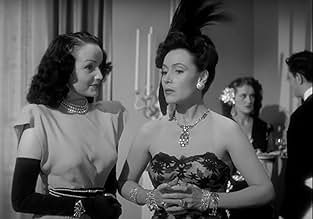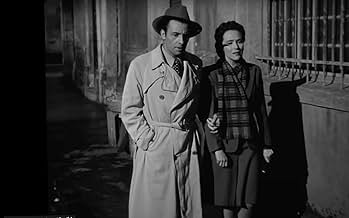Gemelas idénticas: una buena y otra mala.Gemelas idénticas: una buena y otra mala.Gemelas idénticas: una buena y otra mala.
- Premios
- 1 premio ganado y 6 nominaciones en total
Dolores Del Río
- Magdalena Montes de Oca
- (as Dolores del Rio)
- …
José Arratia
- Médico forense
- (sin créditos)
Daniel Arroyo
- Hombre en funeral
- (sin créditos)
Ricardo Avendaño
- Cocinero
- (sin créditos)
Luis Badillo
- Agente policía
- (sin créditos)
Carmen Cabrera
- Invitada a fiesta
- (sin créditos)
Elisa Christy
- Empleada tienda
- (sin créditos)
Carmen Cipriani
- Invitada fiesta
- (sin créditos)
Julio Daneri
- Señor Domínguez
- (sin créditos)
Genaro de Alba
- Hombre en funeral
- (sin créditos)
Felipe de Flores
- Empleado tienda
- (sin créditos)
Argumento
¿Sabías que…?
- TriviaThe script for La Otra was owned by Warner Bros. and is the same script as the 1964 version, Su propia víctima (1963), starring Bette Davis. Warners chose to pass on making it as a film in the 1940's because it bore too close of a resemblance to the film Davis had just made, Una vida robada (1946).
- ConexionesFeatured in Dolores del Río - Princesa de México (1999)
Opinión destacada
Based on a Rian James ' thriller , it was remade with Bette Davis in America as "dead ringer" ,but the first version is much better .They are even shades of "vertigo" in the relationship between Maria turned Magadalena and her ex-suitor ; the last scene is so intense that it's quite possible that the distraught man has finally discovered the horrible truth .And neither "vertigo" nor the French novel on which the screenplay was written "d'entre les morts" existed in 1946.
Death and madness are the keynotes as it would be in "El niño y la niebla "(1953) and "Mascario" (1960)-which began with the feast of dead in Mexico . Like Olivia De Havilland in "the dark mirror" released the very same year , Dolores Del Rio plays two parts ,but unlike the Siodmak psychological suspense , there is no "good one" and "bad one" ;after all when you put Maria and Magdalena together ,you get the name of a biblical woman who was in turn a sinner and a saint .
Physically and morally ,both sisters are worlds apart : Maria looks like a spinster , Magdalena a sexy socialite whose most fervent wish is to get rid of her mourning clothes .Maria is exploited,economically and sexually , by a society that leaves only one hope : to win on the lottery (signs often appear on her way) .
Roberto Gavaldon's directing is ,as usual ,brilliant : the opening scene ,a funeral , the murder (the shot is lost in the din of the firecrackers ,while a clown's head is dangling , a threatening omen (in El niño y la niebla (1953) , in the masked ball ,a terrifying dancer represents madness); when she comes back to her victim's house , the mourners are praying for her brother-in-law 's soul ,and the viewer before he hears the incantations thinks Maria is losing her mind.And afterward she becomes almost crazy in the empty house where shadows and lights create a presence (a sublime shot of a mirror reflects three images of the woman ).
And finally ,when she is aware of her brother-in-law's will ,she will understand she threw away her most precious things ;the buck who woos her (her sister's lover) is a hateful fortune-hunter who blackmails her.
Suspense is sustained till the last minute ,as I write above , and " la otra" compares favorably with the best American films noirs.
Death and madness are the keynotes as it would be in "El niño y la niebla "(1953) and "Mascario" (1960)-which began with the feast of dead in Mexico . Like Olivia De Havilland in "the dark mirror" released the very same year , Dolores Del Rio plays two parts ,but unlike the Siodmak psychological suspense , there is no "good one" and "bad one" ;after all when you put Maria and Magdalena together ,you get the name of a biblical woman who was in turn a sinner and a saint .
Physically and morally ,both sisters are worlds apart : Maria looks like a spinster , Magdalena a sexy socialite whose most fervent wish is to get rid of her mourning clothes .Maria is exploited,economically and sexually , by a society that leaves only one hope : to win on the lottery (signs often appear on her way) .
Roberto Gavaldon's directing is ,as usual ,brilliant : the opening scene ,a funeral , the murder (the shot is lost in the din of the firecrackers ,while a clown's head is dangling , a threatening omen (in El niño y la niebla (1953) , in the masked ball ,a terrifying dancer represents madness); when she comes back to her victim's house , the mourners are praying for her brother-in-law 's soul ,and the viewer before he hears the incantations thinks Maria is losing her mind.And afterward she becomes almost crazy in the empty house where shadows and lights create a presence (a sublime shot of a mirror reflects three images of the woman ).
And finally ,when she is aware of her brother-in-law's will ,she will understand she threw away her most precious things ;the buck who woos her (her sister's lover) is a hateful fortune-hunter who blackmails her.
Suspense is sustained till the last minute ,as I write above , and " la otra" compares favorably with the best American films noirs.
- ulicknormanowen
- 23 ago 2020
- Enlace permanente
Selecciones populares
Inicia sesión para calificar y agrega a la lista de videos para obtener recomendaciones personalizadas
- How long is The Other One?Con tecnología de Alexa
Detalles
- Tiempo de ejecución1 hora 38 minutos
- Color
- Relación de aspecto
- 1.33 : 1
Contribuir a esta página
Sugiere una edición o agrega el contenido que falta

Principales brechas de datos
By what name was La otra (1946) officially released in Canada in English?
Responda



























